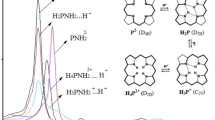Abstract
The distribution of the electrostatic potential of the molecule of porphine (P) and the anions formed by the successive elimination of one and two central protons from it has been studied by the SCF-MO-LCAO method in the all-valence-electron CNDO/2 approximation. The electrostatic potential of the potential of the (P-2HO2− dianion is characterized by the presence of four minima located at a distance of about 1 Å from the nitrogen atoms. The potential in them is equal to −991 kJ/mole. The value of the potential at the center of the opening is −978 kJ/mole. The distribution of the electrostatic potential of the (P-H)− anion with a fixed position of the proton near one of the nitrogen atoms is characterized by the presence of a deep valley situated at the oppositely lying nitrogen atom perpendicularly to the N-H bond. The potential of the molecule of P in the plane of the ring does not have negative values, attesting to the energetic unfavorability of the planar conformations of the (P+H)+ cation.
Similar content being viewed by others
Literature cited
B. D. Berezin, Coordination Compounds of Porphyrins and Phthalocyanine [in Russian], Nauka, Moscow (1978).
J. Hennig and H. H. Limbach, “Kinetic study of hydrogen tunneling in mesotetraphenylporphine by nuclear magnetic resonance, Lineshape analysis and selective T1p-relaxation time,” J. Chem. Soc., Faraday Trans. II, No. 5, 752–766 (1979).
B. W. Roberts, J. D. Roberts, G. Binsch, and J. B. Lambeat, “Nitrogen-15 magnetic resonance spectroscopy. 2. Coupling constants,” J. Am. Chem. Soc., 86, No. 24, 5564–5570 (1964).
J. Brickmann and H. Zimmermann, “Lingering time of the proton in the wells of the doubleminimum potential of hydrogen bonds,” J. Chem. Phys., 50, No. 4, 1608–1618 (1969).
G. I. Bersuker and V. S. Polinger, “The pseudo-Jahn-Teller dynamics of central protons in porphines,” Chem. Phys., 86, No. 2, 57–65 (1984).
J. A. Pople and D. L. Beveridge, Approximate Molecular Orbital Theory, McGraw-Hill, New York (1970).
V. G. Maslov, “Program which realizes the CNDO method in a basis with up to 232 orbitals,” Zh. Strukt. Khim., 18, No. 2, 414 (1977).
C. A. McAuliffe ed., Techniques and Topics in Bioinorganic Chemistry, Macmillan, London (1975).
P. Politzer and D. G. Truhlar eds., Chemical Applications of Atomic and Molecular Electrostatic Potentials, Plenum Press, New York-London (1981).
D. J. Anthony, “Necessary conditions for the calculation of useful electrostatic isopotential maps from CNDO/INDO wave functions,” Theor. Chim. Acta, 59, No. 1, 81–85 (1981).
V. A. Kus'mitskii, A. N. Sevchenko, and K. N. Solov'ev, “CNDO/2 calculation of the adiabatic potential of the intramolecular rearrangement of the porphine molecule,” Dokl. Akad. Nauk SSSR, 239, No. 2, 308–311 (1978).
A. Stone and E. B. Fleischer, “The molecular and crystal structure of porphyrin diacids,” J. Am. Chem. Soc., 90, No. 11, 2735–2748 (1968).
Author information
Authors and Affiliations
Additional information
Translated from Teoreticheskaya i Éksperimental'naya Khimiya, Vol. 22, No. 2, pp. 216–220, March–April, 1986.
Rights and permissions
About this article
Cite this article
Zayats, V.Y., Pinchuk, V.M. & Lobanov, V.V. Motion of protons in the central opening of porphyrins. Theor Exp Chem 22, 201–204 (1986). https://doi.org/10.1007/BF00519194
Received:
Issue Date:
DOI: https://doi.org/10.1007/BF00519194




